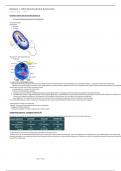Class notes
Introduction to Microbiology
- Course
- MICR271 (MICR271)
- Institution
- Queen’s University (QU )
Complete set of notes from Microbiology course including: -Microbial Evolution & Diversity -Impact of microbial structure on survival -Microbial metabolism and environmental influences -Replication, transcription, and regulation of gene expression -Interactions between microbes and the enviro...
[Show more]



